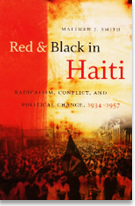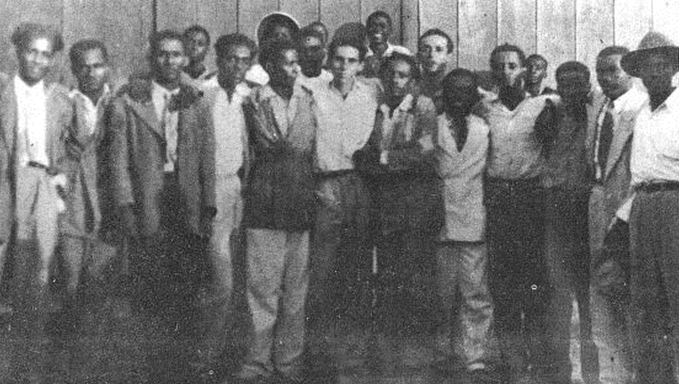 "The Revolution of 1946" by Matthew J. Smith, Ph.D.
"The Revolution of 1946" by Matthew J. Smith, Ph.D.
Smith is Senior Lecturer in the Department of History and Archaeology at the University of the West Indies in Mona, Jamaica. He is the author of Red and Black in Haiti: Radicalism, Conflict, and Political Change, 1934-1957 (2009).
In many ways Haiti entered its modern political era with the Revolution of 1946. Color and class conflicts in the country deepened under the leadership of élie Lescot, who succeeded President Sténio Vincent in 1941. Lescot ruled with a firm hand and like Vincent relied heavily on the Garde d’Haïti (the former gendarmerie) to retain his rule. Still, he was unable to contain the radical impulses unleashed by the victory of the Allied forces in 1945. Young Marxists in Haiti drew much inspiration from the Russian Revolution, the Spanish Civil War, French Marxists, André Breton and the Surrealist movement and the previous generation of Haitian communists, particularly the celebrated Marxist poet Jacques Roumain, whose renown and legend grew after his sudden death in 1944.
Defiantly revolutionary in their outlook, these Marxist students, which included the gifted writers Jacques Stephen Alexis, René Depestre, and Gérald Bloncourt, were not only agitated by elite abuse of political power, but also the interference of the United States in Haitian politics and economy during WWII. In the 1946 New Year’s edition of their organ La Ruche, they called for a dramatic reorientation of Haitian politics and an end to dictatorship in Haiti. Lescot’s forced closure of the press prompted a mass student protest led by members of the La Ruche collective. Within days the student protest swelled to a large countrywide strike. A helpless Lescot was forced to resign.
In the aftermath of the "1946 Revolution" Haiti experienced a period of intense radical activity. For the first time in the country’s history, there was a flurry of radical newspapers and dozens of political parties formed, including several prominent leftwing parties. Among them was a revived Parti Communiste Haïtien (PCH) and the Parti Socialiste Populaire (PSP). The PSP was led by former allies of Roumain and had stronger connections with Marxist groups in Cuba, the Dominican Republic, and the United States.
But it was the noiriste groups that held the greatest influence in 1946. Noiriste radicalism owed a great deal to the expansion of black consciousness in the forties and the late development of a labor movement in 1946. The leading figure in the labor movement and of the pre-Duvalier era was unquestionably Daniel Fignolé. A young mathematics teacher and writer from a poor rural background, Fignolé was an extraordinarily gifted orator with phenomenal appeal among the urban majority in Port-au-Prince. Fignolé’s emergence on the political scene in 1946 was attributed to his unique ability to tap into the concerns of the majority of Haitians in dramatic speeches delivered in Kreyòl.
Noiriste writers regarded Fignolé as the epitome of their hopes and his enormous following saw him as a savior from the political dominance of the bourgeoisie. Fignolé’s party, Mouvement Ouvrier et Paysan (MOP) was formed in 1946 and became the largest labor organization in Haitian history. In spite of Fignolé’s magnetism, and the radical agenda of the Marxists, the United States and the Garde d’Haïti, remained the most important powerbrokers in 1946. Under the direction of the Garde elections were held on August 16 and resulted in the victory of Dumarsais Estimé, a deputy from Verettes with noiriste sympathies. Estimé’s four-year administration proved to be one of the more progressive of the twentieth century.

